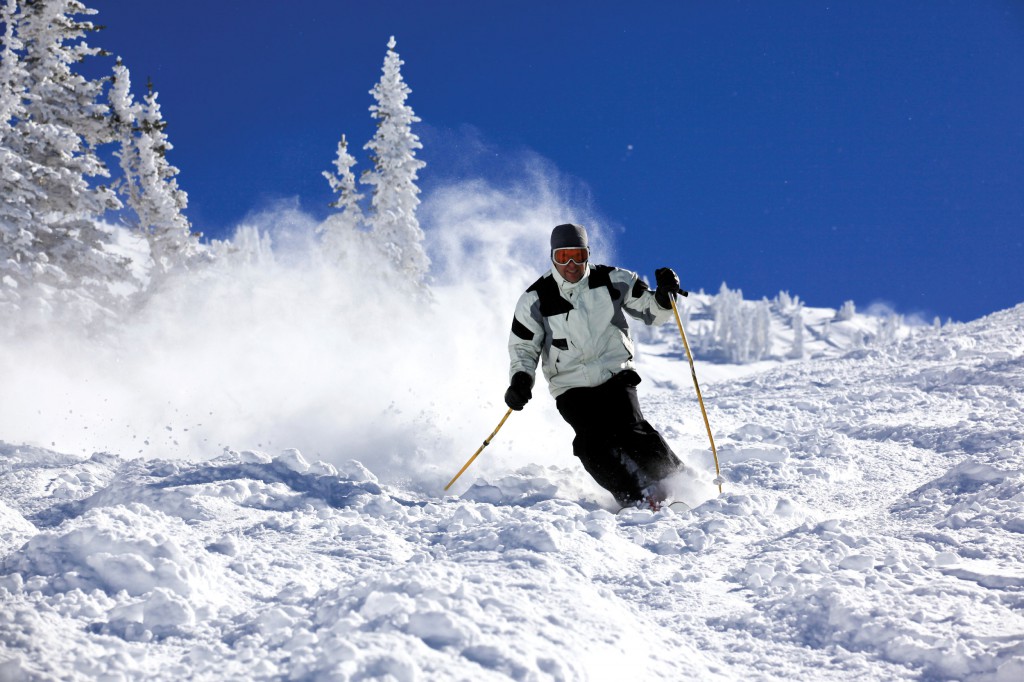Diet and fitness tips for a better, safer ski season.

By Molly Newman
The first Monday of every ski season brings a plague of snow-related ailments to the office—sore backs, twisted knees, and bone-deep exhaustion. Avoid the curse of the weekend warrior by getting in slope-ready condition before the first flakes fall. With these tips for shaping up your diet and fitness routine, you’ll be set for a stronger, healthier, and safer season.
Eating Right
Many athletes take an “eat what you want” approach, figuring their workouts will compensate for the calories in that burger or extra beer. Not so, says Kary Woodruff, sports dietitian at Salt Lake City’s The Orthopedic Specialty Hospital (TOSH). “Athletes have slightly higher needs for protein and some other nutrients,” she says. “It’s important to plan carefully to make sure you’re meeting all your needs without filling up on empty calories.”
Though convenience foods, such as protein powders and energy bars, offer quick hits of energy, you can better nourish your body by turning to whole-food alternatives instead. Woodruff suggests whipping up a quick smoothie of low-fat milk, Greek yogurt, and a few handfuls of frozen berries for an alternative to protein shakes. You’ll get a healthy dose of calcium, Vitamins A and C, and lean protein without added chemicals.
Concerned that your diet may not hit all the right nutritional notes? A multivitamin that meets 100% of the U.S. RDA for most vitamins and minerals may be a wise investment. Avoid megadose brands that include huge measures of any one nutrient, though, Woodruff advises. At best, those extra vitamins will be headed down the sewer; at worst, they can actually damage your health.
What about muscle-building supplements? Think carefully before adding them to your training plan. Creatine is one proven muscle-builder, but “it can cause bloating, water retention, and lethargy,” Woodruff warns—not problems you want during a day on the mountain. If you’re not working closely with a qualified trainer, skip the pills and focus on building strength without shortcuts instead.
Get three recipes that make the most of winter’s fresh (and frozen) fruits and veggies on page 29.
Training Right
“The number-one priority for skiers and snowboarders should be aerobic fitness,” says Dr. James Walker, director of sport science at TOSH. Being aerobically fit wards off fatigue: the primary cause of skiing injuries. (It’s why so many accidents happen on the last run of the day.) Add extra cardio workouts to your training plan as the season nears, and shake up your routine with new cross-training moves like jumping rope or salsa dancing.
One bad tumble can put an end to your whole season. Cut your chances of being sidelined by building core strength. The muscles in your hip girdle and abs will help you stay upright and well-balanced on the toughest slopes. “You can have the strongest legs in the world, and you’ll still topple over if you lack core strength,” Dr. Walker says. Tried-and-true moves like planks and side bends are proven core builders; for variety, try working out with a physio ball or taking a Pilates class.
To help prevent knee injuries, build leg strength with moves such as single-leg squats and leg extensions. “Avoid damaging your knees by lifting with both knees, then lowering with one,” Dr. Walker suggests. Or, to build cardio and leg strength at the same time, try walking backwards on a treadmill set at an incline.
Even the most in-shape skier can wrench a knee or shoulder sometimes. Dr. Walker advises, “As good as it may feel, stay out of the hot tub after an injury. Ice the area regularly instead, and see your doctor if pain gets worse when you’re exercising after the first couple of days.”
Online Bonus: See an illustrated guide to three top leg-strengthening exercises online at sportsguidemag.com.
Drinking Right
Even athletes who watch their diets and train rigorously often fall prey to one of the most common mistakes made by skiers and snowboarders: not drinking enough water while on the slopes.
“It’s easy to forget to drink in the cold,” Woodruff says. “But you’re still sweating, despite the low temperature. Plus, every time you see your breath, that means you’re experiencing respiratory water loss.”
Many skiers don’t want to take time out to grab a drink, let alone make a pit stop for a bathroom break. That’s a dangerous idea, according to Dr. Walker: “When you’re dehydrated, you’re more likely to become fatigued, and that makes you vulnerable to injury. You also need water to flush toxic byproducts out of your muscles; without enough water, you’re going to experience muscle soreness.”
 Fend off dehydration by taking hydration breaks every one to two hours. You can minimize your off-slope time with a portable hydration device like the CamelBak Zoid, which features insulation and a frost-proof tube to keep your drink from icing up.
Fend off dehydration by taking hydration breaks every one to two hours. You can minimize your off-slope time with a portable hydration device like the CamelBak Zoid, which features insulation and a frost-proof tube to keep your drink from icing up.
Armed with these tips, you’re ready to get into the best ski shape of your life. Hit the slopes with a leaner, fitter, readier body—and don’t forget to bring your water!
 Molly Newman lives in Portland, Oregon, where she hikes, walks, and runs whenever it isn’t raining—and often when it is. A contributor to Outdoor Sports Guide since 2009, she also hosts regular trivia nights and homeschools her two sons.
Molly Newman lives in Portland, Oregon, where she hikes, walks, and runs whenever it isn’t raining—and often when it is. A contributor to Outdoor Sports Guide since 2009, she also hosts regular trivia nights and homeschools her two sons.

